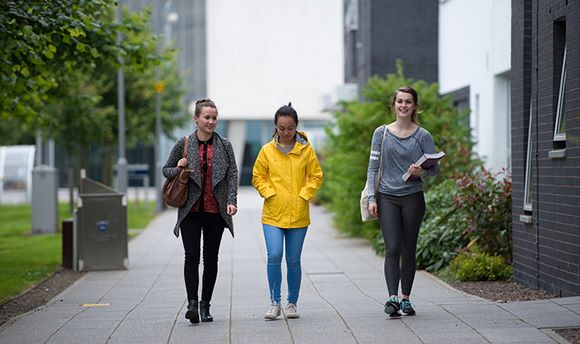Gender Representation on Public Boards 1/1/2023 - 31/12/24
This report has been produced under obligations placed upon the University under the requirements of the Gender Representation on Public Boards (Scotland) Act 2018. The stated intention of the Gender Representation on Public Boards (Scotland) Act 2018 is to help address the historic and persistent underrepresentation of women in public life.
This report covers the period 1 January 2023 to 31 December 2024. Definitions set out below reflect the guidance published by the Scottish Government, updated in June 2025: Reporting on progress - Gender Representation on Public Boards (Scotland) Act 2018: statutory guidance - gov.scot
The Court is the governing body of Queen Margaret University, established by the Queen Margaret University, Edinburgh (Scotland) Order of Council 2007 which came into force on 1 April 2007.The University is a company limited by guarantee (Company Number SC007335) and a charity (Scottish Charity No. SC002750) registered with the Office for Scottish Charities (OSCR). Court members are consequently Directors and also Charitable Trustees.
Details of the powers and governance framework of Queen Margaret University, Edinburgh can be viewed on the University's website.
Appointments to the University’s Governing Body (The University Court) are made in accordance with arrangements set out in the University’s governance documents, and in accordance with section 10 of the Higher Education Governance (Scotland) Act 2016 (which contains provisions on the composition of governing bodies) and, in the case of the ancient universities, with the Universities (Scotland) Acts. In addition, the Scottish Code of Good Higher Education Governance sets out provisions on Higher Education Governance, including best practice in relation to governing body membership and appointments.
Court members are drawn from a range of backgrounds and professions, and include staff, student and Trade Union members. Reference to ‘non-executive’ members in this report replicates the wording of the Act 2018, but refers to those members of the University Court defined as ‘Lay Members’ of the Court. Between 11 and 15 of the members are ‘Lay’ members, who bring with them skills and experience of value to the University. The Chair of the University Court is the ‘Senior Lay member’.
At January 2023, the University met the gender representation objective, having 50% of non-executive members who are women. At this date, there were seven female lay members of the Court, and seven male lay members of the Court. This balance in favour of female lay members was 53% with the inclusion of the Senior Lay member (the Chair of the Court).
At December 2024, Queen Margaret University met the gender representation objective, having 50% of non-executive members who are women. At this date, there were seven female lay members of the Court, and seven male lay members of the Court. The balance in favour of female lay members was 53% if the Senior Lay member is included (ie the Chair of Court)
Note: As required by the Higher Education Governance (Scotland) Act 2016, the Senior Lay member is appointed by a process of election. Candidates for the role go through a process of application and shortlisting by a governing body (Court) appointment panel, with those candidates meeting the criteria for appointment standing for election. It is accepted that the Senior Lay member is an ‘excluded position’ as per Schedule One of the Gender Representation on Public Boards (Scotland) Act 2018. Nevertheless, the role is included in the assessment of non-executive members of the University Court for completeness.
The table below provides information on the consideration of applications for non-executive membership of the University Governing body. The terminology used reflects the terminology of the Act and the requirements of Scottish Government reporting on the operation of the Act.
|
Name of HEI |
Reg. 2(2)(a) Has Gender Rep. Objective been Met? |
Percentage of women on boards at December 2024 |
Reg. 2(2)(b) No. of Non- Exec vacancies
1 January 2023 to 31 December 2024 |
Reg. 2(2)(c) For each vacancy how many recruitment competitions were held? |
Total no. of applications for each competition |
Percentage of applications from women for each competition |
Appointment made for each competition |
Whether the appointment(s) made was/were a woman/women |
|
Queen Margaret University Edinburgh |
Yes |
50% not including the Senior Lay Member, and 53% including Senior Lay member (see note below).
|
There was a total of 7 vacancies, to which candidates were recruited in two separate competitions – in September 2023 and July 2024.
Competition 1: 4 vacancies. Competition 2: 4 vacancies (one carried forward from Competition 1).
|
Two recruitment competitions over the period as noted in previous column. |
Competition 1: September 2023: 9 applicants, of which 3 were women.
Competition 2: July 2024: 8 applicants, of which 3 were women
|
Competition 1: 33% of applicants were women (3/9). Three (3) of the seven (7) interviewees were women.
Competition 2: 37.5% applicants were women. Three (3) of the five (5) interviewees were women.
|
Competition 1: Three (3) appointments made.
Competition 2: Two appointments made.
Two vacancies held over. |
One (1) of the three (3) appointees was a woman.
Competition 2: Both appointments were women.
Two vacancies held over |
The recruitment rounds reported above were conducted in line with previous rounds, with gender balance, as well as the wider diversity profile of the University Court, and its skills matrix, determining the focus of the candidate specification. The Advance HE Toolkit on board diversity provided guidance on appropriate equality considerations, including language employed in the role specification.
The following text is included in the supplementary information provided to applicants and in the advertisement for lay members.
‘The appointment process is being overseen by the Nominations Committee of the Court. Members of the Nominations Committee are committed to ensuring that the process for appointment supports fully the University’s commitment to securing an appropriate balance of independent members on the University Court in terms of equality and diversity. This commitment aligns with the University’s purpose and values. We see our Purpose as helping to create a better society through education, research and innovation, and by providing a supportive and creative learning environment in which students and staff thrive. That purpose is underpinned by our Values, which embrace equality, diversity, inclusion, respect, and supporting our communities. Opportunities and access are open to all and on a fair basis.
In appointing to vacancies we are looking to rebalance and, in some areas, enhance the Court in terms of membership skills and experience; and in terms of member diversity, to better reflect the communities the university serves. We recognise the value that diversity of perspectives and lived experiences brings to Court, and therefore would welcome and encourage applications from people who identify as Black, Asian or from a Minority Ethnic background, and to preserve gender balance on the Court in accordance with the Gender Representation on Public Boards (Scotland) Act 2018, we would welcome and encourage applications from women.
Within the Person Specification, we state the following:
Court appointments take account of personal and professional skills and experience in the context of the overall composition of the Court. In appointing to current vacancies, we are looking to rebalance and in some areas, enhance the Court in terms of membership skills and experience, and in terms of member diversity. We welcome and encourage applications from people who identify as Black, Asian or from a Minority Ethnic background, and from disabled people. To preserve gender balance on the Court, we would welcome and encourage applications from women.
The University promoted its vacancies on its website, and through a number of targeted portals/sites, including Women on Boards, CUC Board vacancy portal, NEDonBoard, Advance HE Board Vacancy Portal, Goodmoves, Alumni networks, and targeted mailing to specific professional bodies reflecting the skills matrix.
In May 2024, to strengthen the ability of our governing body to reflect the rich diversity of the groups we serve, we launched QMU’s Board Apprenticeship Scheme, GIVE. Open exclusively to alumni in the first instance, GIVE offers people without board experience formal training and mentoring in governance, along with the opportunity to witness the work of our governing body (the University Court) in action. It is designed to provide a pathway into full membership of the Court. Details of that scheme can be found here: https://www.qmu.ac.uk/give
The first GIVE scheme participant is a woman.
The University Mainstreaming Report 2025-29 (published in April 2025) includes at Equality Outcome 1 the following commitment carried forward from the previous Report: ‘By 2029, our workforce will have increased in diversity to better reflect the communities it serves, with current evidence gaps filled. This diversity is represented on decision making bodies of the University’.
Page 17 of the current report states: ‘During Session 2024-25, we have maintained the gender balance required under the Gender Representation on Boards legislation. The gender balance of membership of Court was maintained at 50% female and 50% male. The lay member gender balance was 50% female and 50% male.’
Further detail and progress at April 2025 on this particular outcome is published here: https://www.qmu.ac.uk/about-the-university/equality-and-diversity/mainstreaming-report-equality-outcomes-and-employee-information/
Further information on University Court membership September 2025: https://www.qmu.ac.uk/about-our-staff/court/



